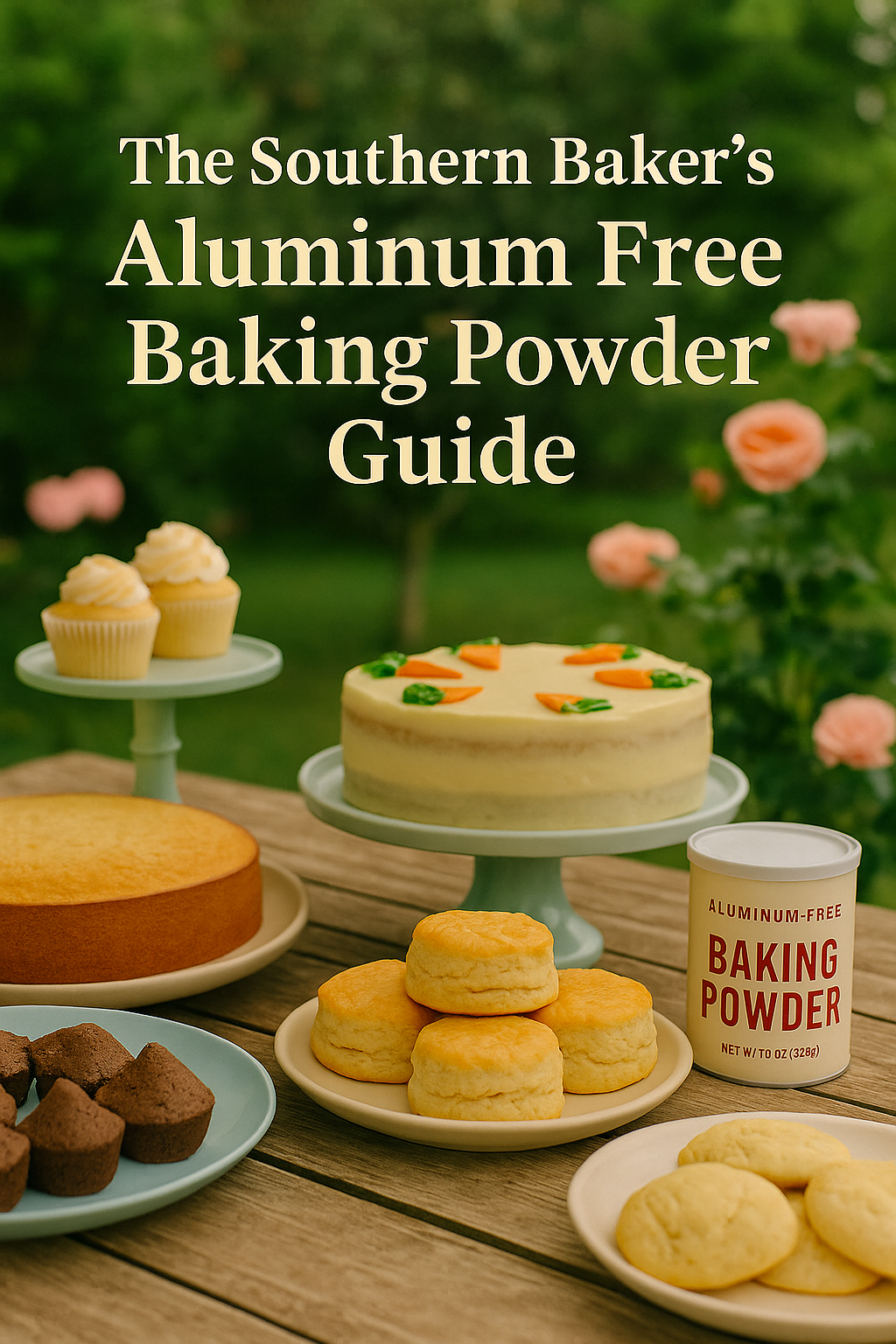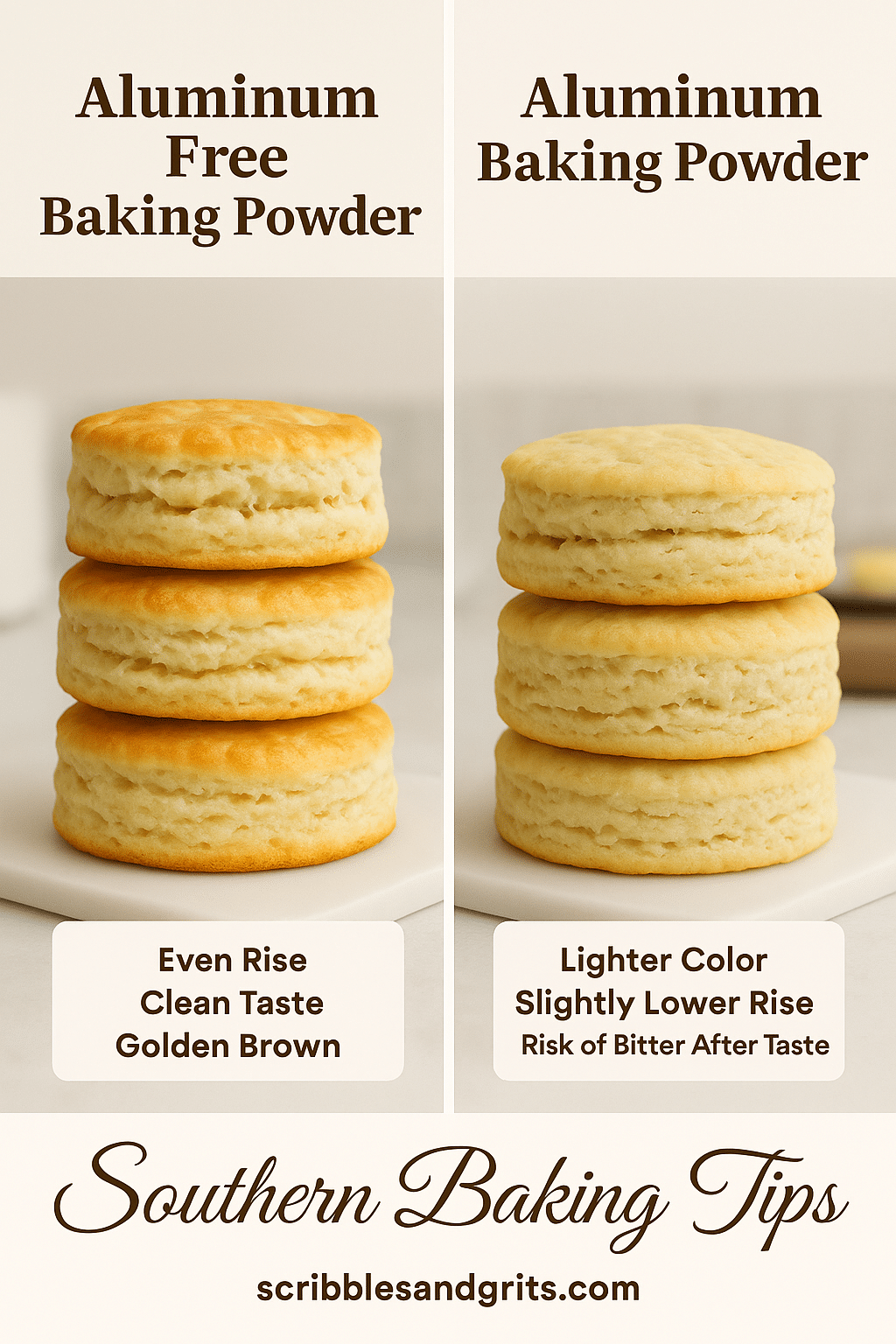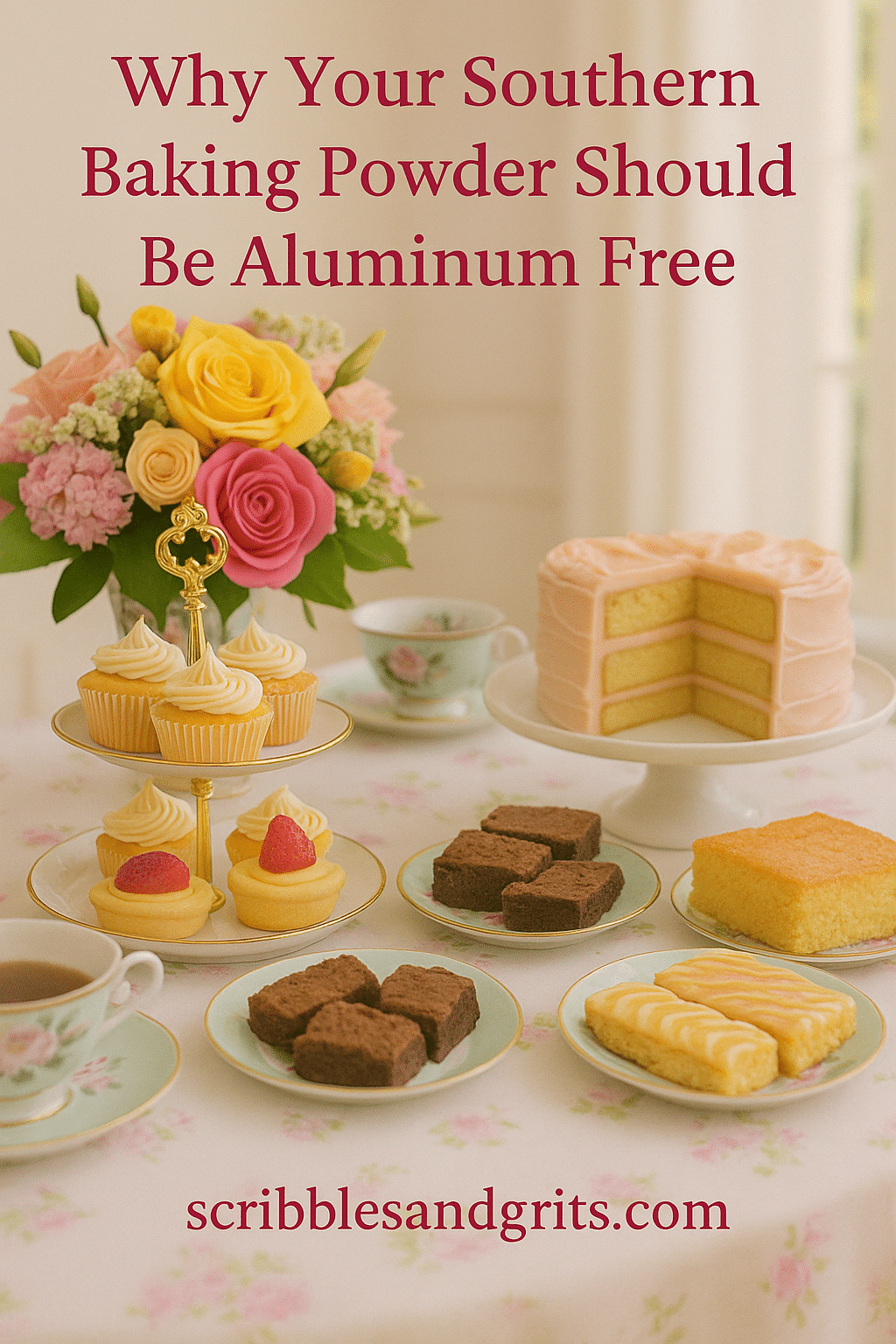The Southern Baker’s Guide to Aluminum Free Baking Powder
I always thought I was following Grandma’s buttermilk biscuit recipe to a T—until a faint metallic tang made me question everything.
Turns out, it wasn’t my technique—it was the baking powder.

Disclaimer
As an affiliate, I may earn commission from qualifying purchases made through links on Scribbles and Grits™, from Amazon, and other third parties, at no additional cost to you.
Swapping in aluminum free baking powder was a game-changer, and I haven’t looked back since.
If you’re baking up biscuits, cornbread, or cakes in your Southern kitchen, this might just be the secret ingredient you didn’t know you needed.
What Is Aluminum-Free Baking Powder?
What Is Aluminum Free Baking Powder?
Let’s settle this biscuit debate once and for all: aluminum free baking powder uses monocalcium phosphate as its acid, while the regular kind often contains sodium aluminum sulfate.
That tiny swap makes a big difference in your Southern kitchen—especially when it comes to taste.
Here’s why I only keep aluminum free baking powder in my pantry—and why you might want to do the same:
Aluminum free baking powder (like Rumford):
- Ingredients: Monocalcium phosphate, sodium bicarbonate, cornstarch
- How it works: It reacts immediately with liquid and again with heat, giving biscuits, cakes, and cobblers that perfect rise—without a trace of metallic aftertaste.
- Best for: Recipes where clean, delicate flavor is essential—think tea cakes, angel food cake, or a peach cobbler that lets the fruit shine.
Regular baking powder (with aluminum):
- Ingredients: (you may see either)
– Cornstarch, sodium aluminum sulfate, monocalcium phosphate, sodium bicarbonate
– Cornstarch, sodium aluminum phosphate, sodium bicarbonate - How it works: Needs oven heat to fully activate, making it more suited to batters that sit before baking.
- Why I skip it: That bitter aftertaste can sneak into lightly sweetened Southern staples like cornbread, biscuits, and pound cake—and that’s a no for me.
Why Aluminum Still Shows Up in Regular Baking Powder
Now, you might be wondering: If the flavor isn’t great, why is aluminum still in baking powder at all?
Great question!
Here’s why it’s used in commercial and industrial baking:
- Controlled leavening for large-scale baking:
Aluminum-based baking powders are double-acting—they activate a little during mixing, but the bulk of their rising power kicks in once heat is applied. This delay is ideal for commercial kitchens, where batter often sits before it hits the oven. - Cost-effective and shelf-stable:
Ingredients like sodium aluminum sulfate are cheap and last longer, which makes them practical for bulk baking mixes and packaged goods. - Used beyond baking:
Sodium aluminum phosphate also shows up in processed foods (like certain cheeses) to help with texture and meltability—but that’s a different story for another day.
Aluminum Free Baking Powder vs. Regular: Do You Need Both?
Not unless you’re running a commercial bakery out of your kitchen. For home baking—especially Southern-style recipes that thrive on tender texture and clean flavor—aluminum free baking powder is the best choice every time.

Still curious or crafting recipes that sit for a bit before baking? That’s the only time aluminum-based powders might come in handy. Otherwise, skip the metallic zing and keep it simple with aluminum free.
Double-Acting vs. Single-Acting Baking Powder: What You Need to Know
Why Most Recipes Call for Double-Acting (and When It Matters)
If you’ve ever squinted at a recipe that calls for “double-acting” baking powder and thought, What does that even mean? — You’re not alone.
In the great double-acting vs single acting baking powder debate, the difference comes down to timing.
Let’s break it down:
How Double and Single-Acting Baking Powder Work
Double-Acting Baking Powder (the kind you’ll find in most grocery stores):
- First rise: Reacts a little when mixed with liquid (think buttermilk biscuits).
- Second rise: Activates again with heat in the oven—this gives your baked goods that extra lift.
- ✅ Perfect for: Batters that might sit before baking (like muffins or cookies).
Single-Acting Baking Powder (less common, but used in professional kitchens):
- One quick rise: Reacts fully as soon as it’s mixed with wet ingredients.
- ✅ Perfect for: Quick griddle recipes like pancakes or donuts—where you mix and bake right away.

Why Double-Acting Baking Powder Is in Most Pantries
- More forgiving timing: Didn’t preheat the oven? No worries. That second heat-activated rise has your back.
- Better texture: It gives a consistent crumb and helps prevent tunneling or collapsing.
- Longer shelf life: Brands like Rumford and Bob’s Red Mill offer double-acting, aluminum-free options that store well.
When Single-Acting Baking Powder Still Shines
- In commercial kitchens: Donut shops and pastry pros use single-acting powders to control the rise with precision.
- In DIY baking powder recipes: Homemade blends (like cream of tartar + baking soda) are single-acting—so once mixed, you’ll need to bake immediately for best results.
Can You Substitute Double-Acting and Single-Acting Baking Powder?
Yes—but timing is everything.
✅ Using double acting instead of single?
You’ve got more wiggle room. The heat-activated rise gives you a buffer.
✅ Using single acting instead of double?
You’ll need to work fast—get that batter in the oven right away to capture the rise.
And there’s one more thing you need to know.
Timing Matters When Aluminum Free Baking Powder and Buttermilk Meet
Did you know aluminum free baking powder starts working the moment it hits your buttermilk? That means your biscuits are on a ticking clock!
👉 Click here to learn why speed matters—and how to keep your biscuits sky-high and fluffy.
A Southern Baker’s Guide to Grocery Store Baking Powder
Let’s make your next grocery trip simple. Whether you’re trying to avoid aluminum, manage food allergies, or just bake better biscuits, here’s how to spot the right aluminum-free baking powder.
How to Read a Baking Powder Label (Without Getting Tripped Up)
Flip the canister and look for:
- ✅ Aluminum Free? Check for monocalcium phosphate, cream of tartar (in homemade blends), or sodium acid pyrophosphate.
- ✅ Double-Acting? Most store-bought powders are—it should say so on the label.
- ✅ Corn-Free? Look for starches made from potato or tapioca.
- ✅ Grain-Free or AIP-Friendly? Look for cassava-based starches.
- ✅ Top 9 Allergen-Free? Check for allergen-free labeling and dedicated facility notes.
- ✅ Gluten-Free? Most are, but a certified gluten-free label offers extra peace of mind.
- 🚫 Avoid anything with “sodium aluminum sulfate,” or “sodium aluminum phosphate or “aluminum” listed anywhere.
Baking Powder Comparison Guide
| Baking Powder Brand | Aluminum Free | Gluten Free | Corn Free | Top 9 Allergen Free | Double Acting | Notes |
|---|---|---|---|---|---|---|
| Rumford | ✅ | ✅ | ❌ | ❌ | ✅ | Contains cornstarch; owned by Clabber Girl |
| Clabber Girl | ❌ | ✅ | ❌ | ❌ | ✅ | Contains sodium aluminum sulfate |
| Bob’s Red Mill | ✅ | ✅ | ❌ | ❌ | ✅ | Some versions use sodium acid pyrophosphate |
| Argo | ✅ | ✅ | ❌ | ❌ | ✅ | Newer aluminum free option with SAPP |
| Hain Featherweight | ✅ | ✅ | ✅ | ❌ | ✅ | Uses potato starch; corn free |
| Otto’s Naturals | ✅ | ✅ | ✅ | ✅ | ✅ | Grain free, nightshade free, AIP compliant |
| Mom’s Place | ✅ | ✅ | ✅ | ✅ | ✅ | Top allergen free choice; dedicated facility |
| Whole Foods 365 | ✅ | ✅ | ❌ | ❌ | ❌ | Single acting |
| Bakewell Cream | ✅ | ✅ | ✅ | ❌ | ❌ | Requires mixing with baking soda; single acting |
| I’m Free | ✅ | ✅ | ✅ | ❌ | ❌ | Single acting; no starches |
| Royal | ❌ | ✅ | ❌ | ❌ | ✅ | Contains aluminum |
| Davis | ❌ | ✅ | ❌ | ❌ | ✅ | Contains aluminum |
| Dr. Oetker GF | ✅ | ✅ | ❌ | ❌ | ❌ | Check label for gluten free version |
| Dove’s Farm (UK) | ❌ | ✅ | ❌ | ❌ | ❓ | Contains aluminum; availability varies |
| Angel Yeast | ✅ | ✅ | ❌ | ❌ | ✅ | Specializes in aluminum free formulas for texture |
| © Scribbles and Grits™. All rights reserved |
My Trusted Aluminum Free Baking Powder Brands
After baking everything from mile-high biscuits to Christmas cobblers, these are the aluminum-free baking powder brands I turn to most—each for a specific reason:
Rumford Baking Powder: Everyday Favorite
- Aluminum-Free: Yes
- Gluten-Free: Yes
- Double-Acting: Yes
- Contains Cornstarch: Yes (not corn-free)
- Free From: Wheat, soy, dairy, and nuts (based on retailer allergen info)
- Certifications: Non-GMO Project Verified, Kosher
- Ingredients: Cornstarch, sodium bicarbonate, monocalcium phosphate
- Known For: Produces a moist, tender crumb in baked goods
Bob’s Red Mill Baking Powder: Gluten Free Favorite
- Aluminum-Free: Yes
- Gluten-Free: Yes
- Double-Acting: Yes
- Contains Cornstarch: Yes (not corn-free)
- Free From: Wheat, soy, dairy, and nuts (per manufacturer and packaging)
- Certifications: Non-GMO Project Verified, Kosher, Vegan
- Ingredients: Cornstarch, sodium bicarbonate, sodium acid pyrophosphate
- Known For: Clean, consistent rise without a metallic aftertaste
Mom’s Place Baking Powder: Allergy Free Favorite
- Aluminum-Free: Yes
- Gluten-Free: Yes (Certified Gluten-Free; made in a dedicated gluten-free facility)
- Corn-Free: Yes
- Double-Acting: Yes
- Free From: Gluten, corn, dairy, nuts, soy, and other major allergens
- Certifications: Non-GMO, Preservative-Free, MSG-Free
- Ingredients: Sodium acid pyrophosphate, sodium bicarbonate, organic starch (corn-free; exact type not listed)
- Known For: Reliable rise and texture for allergy-sensitive and gluten-free baking
Safety & Quality:
Manufactured on dedicated gluten-free and nut-free equipment in Utah, USA.
Trader Joe’s Baking Powder: Low Cost Favorite
- Aluminum-Free: Yes
- Gluten-Free: Yes (contains no gluten ingredients)
- Double-Acting: Yes
- Contains Cornstarch: Yes (not corn-free)
- Free From: Wheat, soy, dairy, nuts, eggs, fish, shellfish (based on ingredient list)
- Ingredients: Monocalcium phosphate, sodium bicarbonate, corn starch
- Known For: Affordable, aluminum-free option with clean taste and consistent rise
Note: While the ingredient list confirms it is aluminum-free, packaging claims have varied. No official allergen cross-contact policy is listed—those with severe allergies should verify before use.

Homemade Aluminum-Free Baking Powder Recipe
Wondering how to make aluminum-free baking powder at home? This DIY aluminum free baking powder recipe is as easy as pie—just three simple ingredients, no mystery metals, and fresh flavor every time.
Whether you’re trying a new recipe or simply running low on the store-bought kind, DIY baking powder recipes are a handy trick to have in your back pocket.
How I Keep My Aluminum-Free Baking Powder Fresh in My Humid Southern Kitchen
Living with Southern humidity is like having an uninvited guest in your kitchen year-round. Here’s how I keep my aluminum-free baking powder fresh and effective:
How I Test If Baking Powder Is Still Active
Mix 1 teaspoon aluminum-free baking powder with 1/3 cup hot water. If it bubbles vigorously, it’s still good to go. If the reaction is weak or non-existent, and it’s time for a fresh can.
Pro tip: I test every 3 months—aluminum-free baking powder stays fresh up to a year if stored right in our humid Southern climate.
How to Store Aluminum-Free Baking Powder for Maximum Freshness
Aluminum free baking powder stays fresh longer when it’s stored correctly, and a few small habits can make a big difference.
Why Airtight Baking Powder Storage Matters
I keep mine in the original Rumford canister, which comes with a rubber-sealed lid, and that’s been great for keeping moisture out. But no matter the brand, what matters most is that your container is airtight. Exposure to air or humidity weakens the leavening power.
Choose a Cool, Dry Spot
Store it in a pantry or cabinet away from heat and humidity. Avoid placing it near the stove, dishwasher, or windows—anywhere temperature and moisture fluctuate. That’s where clumps and premature reactions happen.
Skip the Fridge
It might seem smart, but refrigeration can cause condensation and invite unwanted odors. Keep it dry, not chilly.
Bonus Tip for Long-Term Baking Powder Storage
If you live in a humid climate, tuck the sealed container into an airtight jar or add a food-safe silica gel packet to absorb excess moisture. No need to freeze—just store smart and use within 3–6 months of opening for best results.
Save or Share This Aluminum Free Baking Powder Tip on Pinterest












